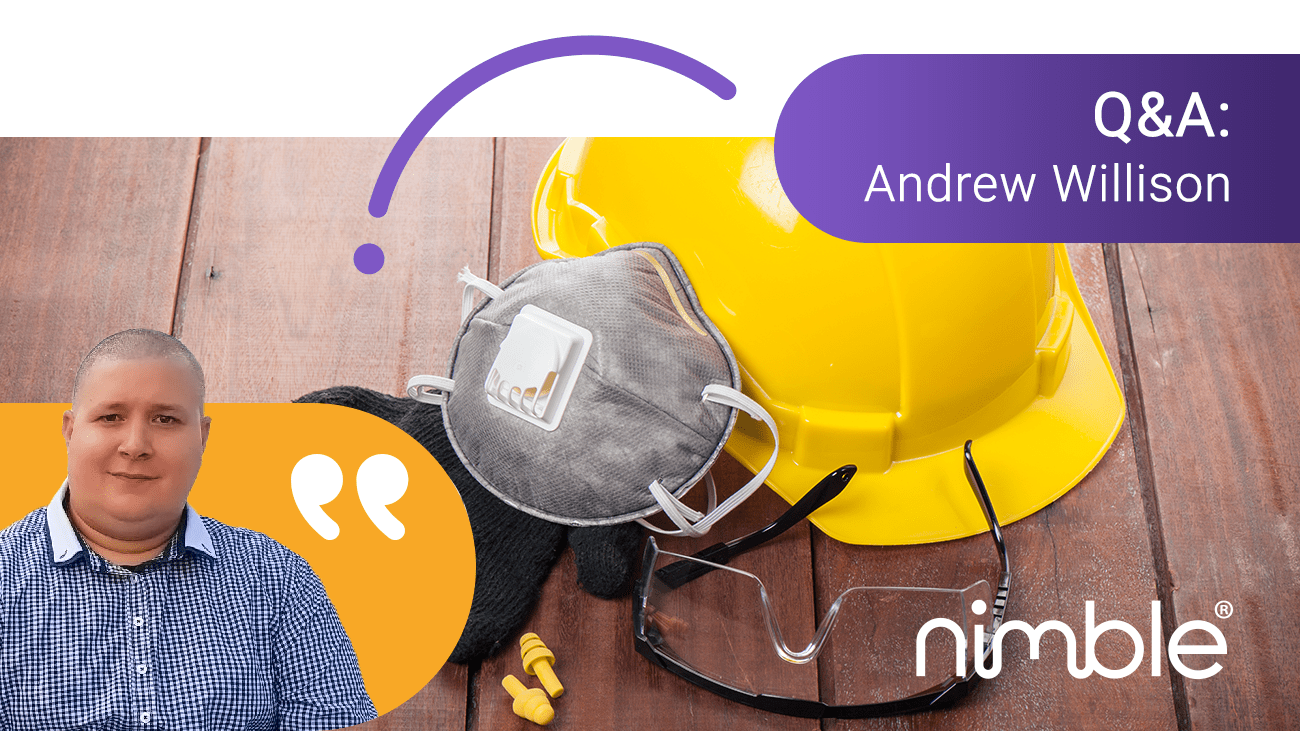
Our Nimble Learning Adviser, Hannah Davies, shares her interview with Andrew Willison, Environment, Health and Safety (EHS) Specialist for Sensient Colors UK Ltd.
 Andrew gives us an insight into the benefits of online learning for health and safety training.
Andrew gives us an insight into the benefits of online learning for health and safety training.
Andrew is highly experienced in health and safety compliance in the leisure and maintenance sectors.
Introduce yourself!
My name is Andrew Willison; my current role is Environment, Health and Safety (EHS) Specialist for Sensient Colors UK Ltd. My role involves day to day environmental, health and safety duties such as writing and implementing policy and conducting various risk assessments including those for work activities, manual handling, Display Screen Equipment (DSE), fire safety and Control of Substances Hazardous to Health (COSHH).
What challenges have you faced in your current and former roles when it comes to training staff to a high standard?
Training is often a tick box exercise to ensure compliance is demonstrated. Often, we forget that compliance is not the most important aspect of training; actually making sure our teams are prepared to work safely is what is important. Obviously, there is a need for records – and these often bring their own issues.
Ensuring that records are kept is very important, and that these records are legible and relevant. One issue I came across previously was proving what was delivered in training. It’s easy to ask for a signature and most people will sign without question. Proving what was trained for is just as important as getting that all important signature.
What impact does elearning have on health and safety training?
Elearning has a place in almost all modern workplaces to help educate staff and keep a record of training. It also allows for bespoke content that appeals to different learning styles and enables delivery of information to a wide audience.
Elearning is a perfect platform for induction that can be completed early in the employment – or even before day one! Periodic training (I use monthly) can have a big impact on H&S culture by helping to keep it at the forefront of the workforce’s attention. Too often, H&S training is done just once a year to prepare for audits.
How do you keep track of learner certification and training in order to maintain the safest possible working environment?
Record keeping is important to ensure that you can track and identify both training and learning opportunities. Elearning allows you to keep digital records of progress, but most importantly it enables you to track understanding by giving you the tools for automated assessments. When these quizzes and tests are correctly written, a vast collection of different questions can be chosen at random to ensure that there is a proper understanding of the course material. This takes assessment beyond a ‘read and sign’ exercise.
Would you recommend Nimble over other authoring tools or learning management systems (LMS)? If so, why?
I researched many learning management systems in my previous role before settling on Nimble. The reason I chose Nimble was its simplicity. It does everything we need it to and is cost effective. The customisation options and ability to write my own content allows me to tailor the courses to my particular training requirements and to the correct level. Off-the-shelf courses have a time and place but bespoke courses allow you to craft exactly what you need.
Have you had any problems persuading staff to complete online training, and if so, how did you encourage compliance?
In the beginning we had issues with getting the team to complete. We found the best way to encourage completion was a mixture of compliance tracking and reporting, with competition between the management teams. This, alongside fun and engaging learning, helped us take our completion rates from under 50% to an average of 96% completing on time. EHS is often dry and serious subject matter, but the odd funny story, strange answer or caption can lighten it up and still get that serious message across. Engaging the audience is the key to having an engaged audience.
What role does face-to-face health and safety training have alongside elearning?
There will always be a need for face-to-face health and safety training. There are just some things you cannot learn from videos and pictures. You need to experience some things in person to get the benefit. Take fire extinguisher training as an example: you cannot get that feel of the weight, the kick back or that sound from a video – you need to experience it first-hand. That’s the part that might give you the confidence to pick one up in the future, in a real emergency scenario. An elearning module just would not be able to convey those aspects. That said, the theory and basic information about extinguishers can be done through elearning – but the live session really ties it together.
We’ve also used a blended approach for competency assessments; on-the-job training is great and teaches you how to do the role, but often the theory and small key details are missed whilst ‘getting the job done’. A blended approach of face-to-face followed by an elearning module with a quiz can be a powerful tool to fill in those gaps and prove competency before you allow that team member to do the job alone (and even train others).
And finally Andrew, what advice do you have for professionals new to the world of EHS?
EHS can be a minefield of legislation and myth. The key is remembering the phrase reasonably practicable and ensuring that every decision is made to that standard. People may say, “it’s how it’s always been done,” or “that’s how we did it elsewhere,” – but that doesn’t mean it’s the way it needs to be done. We can learn a lot from best practice and the experience of the peers before us – but fresh minds and new ways of thinking can be the key to successful safety.

Here’s three advantages for using elearning:
- You can present information in an engaging, interactive way (so it’s more likely to be remembered)
- Enrolling staff in a course using a Learning Management System (LMS) allows you to see who has viewed the content (and send reminders to those who haven’t)
- Learner data can help you demonstrate that all staff have been informed of any changes (to show compliance)


0 Comments